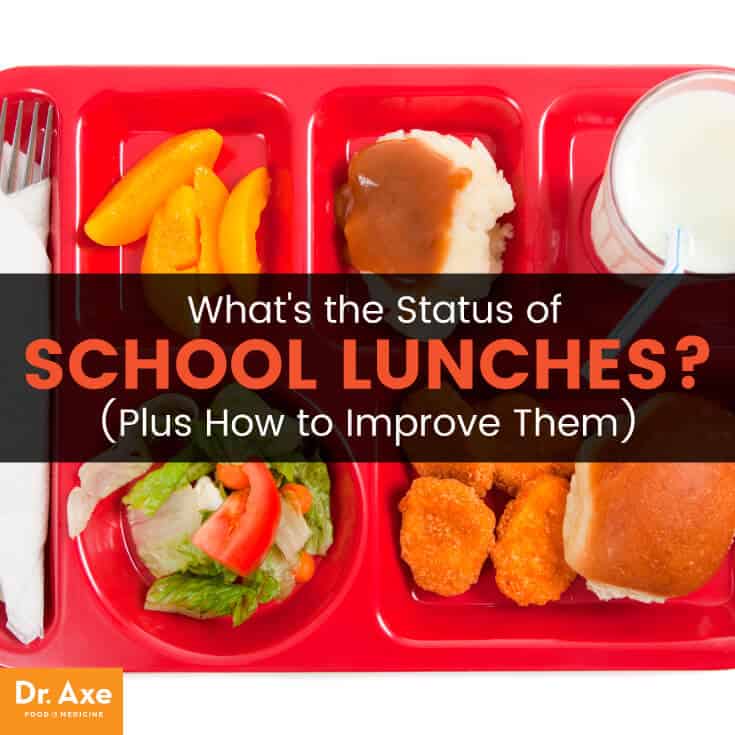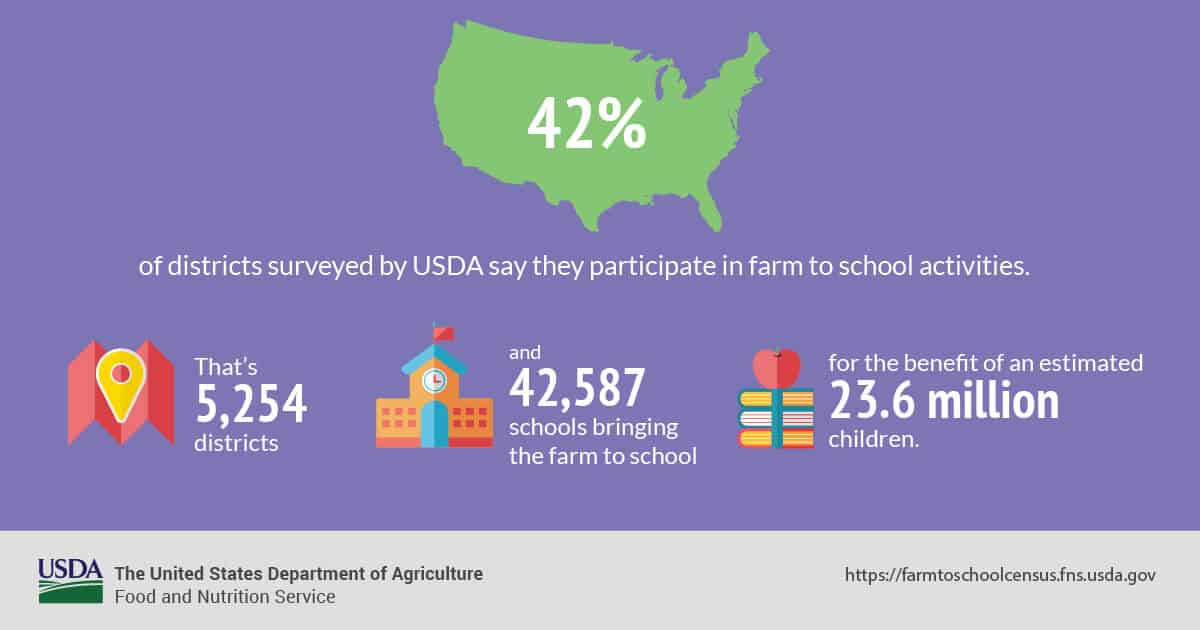
For parents and students alike, the topic of school lunch has always been a hot-button issue. This month, the school lunch debate is back in the spotlight after it was announced that Secretary of Agriculture Sonny Perdue signed a proclamation that scales back school nutritional requirements spearheaded by Michelle Obama and put into practice during the Obama administration in 2012. (1)
This is happening despite evidence that the rules implemented in U.S. Department of Agriculture Healthy, Hunger-Free Kids Act (HHFKA) of 2010 have been effective in providing healthier, nutrient-dense meals in schools. So why the loosened regulations by the USDA here in 2017? Those in favor of more lax standards cite rising costs for school districts, increased food waste and the belief that they won’t have a significant impact on children’s health.
What does this mean, exactly? Should we expect a rising correlation between childhood obesity and school lunches like we had from the 1970s to the early 2000s? Let’s take a look at the pros and cons of both the HHFKA and the new scaled-back USDA guidelines that will go into effect for the upcoming school year, along with healthy school lunch ideas and other ways to ensure your children get the nutrition they need.
School Lunch Changes: Pros and Cons
First, let’s take a look at what the Healthy, Hunger-Free Kids Act did. On the plus side: (2)
- Capped the number of calories that can be in a meal
- Required at least one serving of fruits and vegetables per meal
- Limited sodium content of meals
- Required all grains to be 100 percent whole grain rich
- In addition, according to a study from a Washington state school district in 2016, the levels of calcium, vitamin A, vitamin C, iron, fiber and protein were increased in school lunches, and nearly as many students — 46 percent vs. 47 percent — participated in the school meal program
Downsides:
- Driven up costs for school districts
- Required milk to be fat-free flavored milk — the “fat is evil” hypothesis has been shown to be greatly flawed
- More food waste with a big cost (3)
- Decreased participation in school food program — though research from the Center for Science in the Public Interest found the decrease is due to other factors, not the meal program changes (4)
What about the new changes? The changes take aim at three areas in particular — whole grains, salt and milk — with the goal of making less strict guidelines in those areas. Here are the proposed changes:
- At least half of the grains in a school must be whole grains instead of 100 percent
- Schools don’t have to meet the lowest target of sodium content as outlined by the HHFKA (5)
- Will allow students to get 1% flavored milk instead of being required to get fat-free flavored milk
Let’s take a look at the potential upsides of the changes:
- Decreased waste
- Lower cost
- Belief it won’t affect nutrition much compared to now
As for the downsides:
- Sodium offers no nutrition
- May not increase participation or decrease waste
- Can lead to looser regulations, going back to the way less healthy school lunch programs of yesteryear
School Lunch Problems and Solutions
Even with the stricter regulations that are now being lessened, school lunch problems persist. For starters, while the nutrient value regulations have improved, the real issue is the source of the food itself. As researcher, author, consultant and food educator Sadie Barr wrote for HuffPost: (6)
The biggest problem with school food isn’t that it’s too healthy, or that students are being offered too little. The biggest problem is that industry is feeding our kids, and we’re letting it happen.
As counterintuitive as it may seem, focusing solely on the nutritional value of the items being served at schools is not the best gauge of healthfulness. More important is how, when, and where the food is made, and by whom.
Food suppliers, while having to hit certain nutrition marks, aren’t prevented from utilizing artificial flavors and coloring, added preservatives, emulsifiers, and other food additives.
Then there is the not so insignificant cost — we’re talking cost from all sides: participation, dollars and cost of waste. Students paying full price for lunch is at its lowest point in recorded history, with 258 million fewer lunches served in 2014 than 2010.
Research published in the American Journal of Preventative Medicine estimated that food waste caused by the National School Lunch Program each year may cost more than $1.23 billion. (7) Another report from the Government Accountability Office noted that 48 of 50 states reported challenges in dealing with food waste. (8)
Then there is the cost itself of the program. The programs of the HHFKA cost more than $20 billion per year. (9) That’s led to the price of lunch itself to students to rise nationally, further exacerbating the cost issue. (10)
So how to do you solve these issues? Some schools are finding new ways to feed students, while others simply opt to brown bag it. This is important because a healthy lunch is vital for children’s development. Research shows that eating fast food lowers students’ test scores, while getting proper nutrition improves performance. (11)
Innovative School Lunch Programs
There are schools out there finding innovative ways to keep costs down, keep nutritional value up, and educate children on food and how to consume a healthy diet. Take, for instance, the Farm to School program. The program’s mission is to “increase access to local food and nutrition education to improve children’s health, strengthen family farms, and cultivate vibrant communities.” (12)
It seems to be working:

According to the 2015 Farm to School Census:
During the 2013-2014 school year, these schools purchased $789 million worth of local products from farmers, ranchers, fishermen and other food producers. That is a 105% increase over the $386 million of local food purchased in 2011–2012 and a huge investment in community economic development. Furthermore, 46 percent of school districts reported they will increase their local food purchases in coming school years. While fruits, vegetables and milk currently top the list of foods schools are most likely to buy locally, many indicated that they’d like to buy more plant-based proteins, grains, meats, poultry and eggs from local suppliers.
Forty-four percent of the school districts also reported having at least one edible school garden. In school year 2013–2014, more than 7,101 school gardens gave students daily access to fresh fruits and vegetables, while also helping them learn where food comes from. This is a 196 percent increase over the 2,401 edible school gardens reported in the 2011–2012 school year when the first census was conducted.
Then there is what school lunch looks like in Japan. Schools in Japan simply provide students with the food they typically eat at home, not the “choices are generally provided by large agri-food companies, cooked off site, frozen and then reheated, and forced to compete in cafeterias with all things fried, salty and sweet.” (13)
The Japanese often make school lunch from scratch, focusing on rice, vegetables, fish and soup. In addition, students help serve one another and eat in class, all get the same meal, and don’t have vending machines. Most don’t even allow students to bring bagged lunches and also employ nutritions to work with students who are picky eaters.
Japan does all of this with very few regulations, and funding is a local matter. It’s all about focusing on healthier options and educating children on proper nutrition. It’s led to continually decreases in Japan’s already low obesity numbers.
Other innovative ideas include: (14)
- In Minneapolis, one school district is replacing processed food with meals prepared from scratch in on-site kitchens, holding contests for students to invent cafeteria recipes, and instituting Minnesota Thursdays, when everything on the menu is locally sourced.
- School gardens and cooking classes to engage and teach students.
Brown Bag It: Healthy School Lunch Ideas
One of the reasons schools are so concerned with costs is that the number of students participating in the School Lunch Program has gone down. While this may sound like a bad thing, if your children’s school does not have a farm to school program in place or some other healthy school lunch program, the best option is to brown bag it to create your own healthy school lunch ideas.
Here are some of my favorite ideas:
- Turkey burger on Ezekiel bread with lettuce, tomato and mustard
- Organic, nitrate-free lunch meat on Ezekiel bread
- Almond butter and banana sandwich on brown rice bread
- Chicken salad on a bed of greens
- Egg salad wrapped in a sprouted grain tortilla
- Ants on a log (celery with almond or cashew butter and raisins)
- Antioxidant trail mix
- Fruit and nut bar
- Hummus with carrot sticks, broccoli and cauliflower
- Apples, bananas, oranges, peaches, grapes
- Guacamole with bell pepper slices
- Leftover quinoa from last night’s dinner
- Beans and brown rice with seasonings
- Buffalo chili in a thermos
- Spinach salad with nuts, cranberries and pear slices
- Fresh berries (blueberries, strawberries, raspberries, etc.)
- Homemade lemonade (lemon juice, water and stevia)
- Hardboiled eggs or deviled eggs
- Goat’s milk yogurt
- Gluten-free crackers and goat’s cheese
- Raw zucchini noodles with marinara or alfredo sauce
- Organic or homemade applesauce
- Walnut tacos in lettuce wraps
- Black bean brownies
- A slice of raw cheesecake for dessert
Final Thoughts on School Lunch Changes
- Under the previous administration, the USDA enforced strict guidelines for schools to implement more nutritious school lunches. The results have been positive in regard to more fruits and vegetables and healthier lunches, but rising costs, increased waste and less participation have raised concerns.
- As a result, the regulations in the Healthy, Hunger-Free Kids Act have been loosened for the upcoming school year, allowing some grains that are not whole grain rich, eased sodium standards and 1% milk in addition to fat-free milk. This may ease some financial concerns, but the trade-off is moving back in the direction of unhealthier lunches that can impact obesity rates.
- Proponents of the changes say they won’t affect nutrition much, particularly since suppliers have worked to make healthier food options anyway. However, many food suppliers utilize artificial flavors and coloring, added preservatives, emulsifiers, and other food additives.
- Innovative programs like Farm to School, along with programs to utilize local ingredients, engage students in meal prep, and contests to create recipes and encourage healthy eating have helped improve school lunches.
- Still, students can always pack their own healthy lunches, creating meals full of healthy, natural foods that are free of GMOs, additives and other harmful ingredients.
Read Next: 18 Healthy Lunches for Work for a More Energized Week
From the sound of it, you might think leaky gut only affects the digestive system, but in reality it can affect more. Because Leaky Gut is so common, and such an enigma, I’m offering a free webinar on all things leaky gut. Click here to learn more about the webinar.
